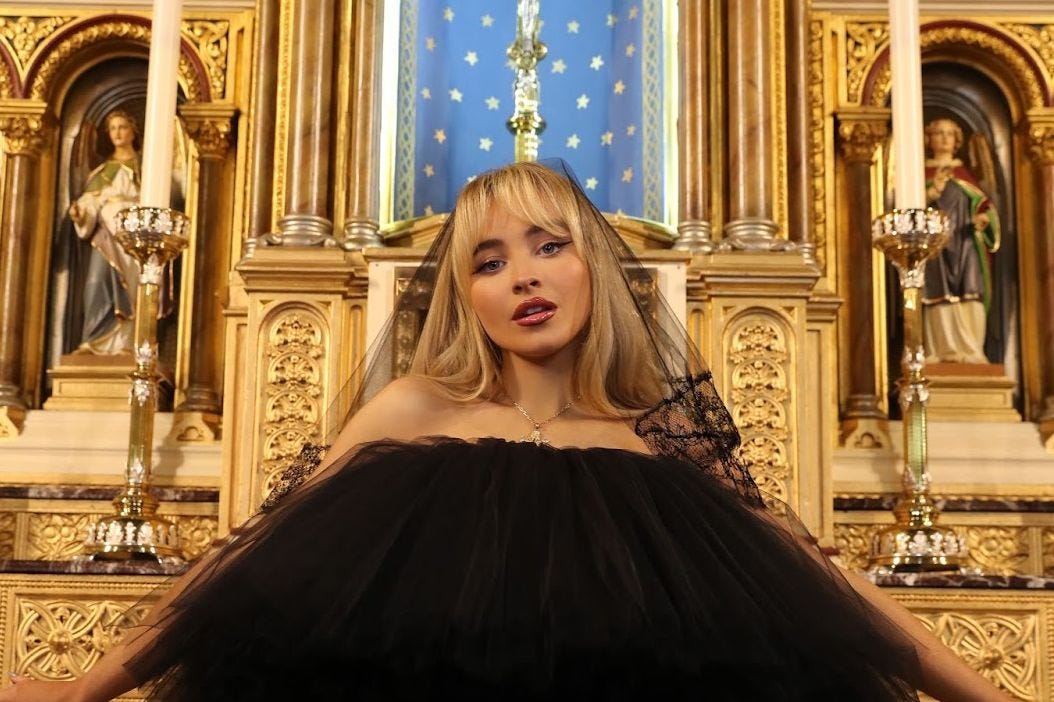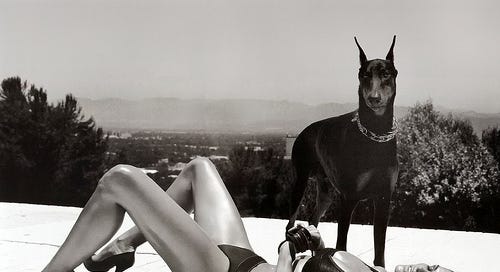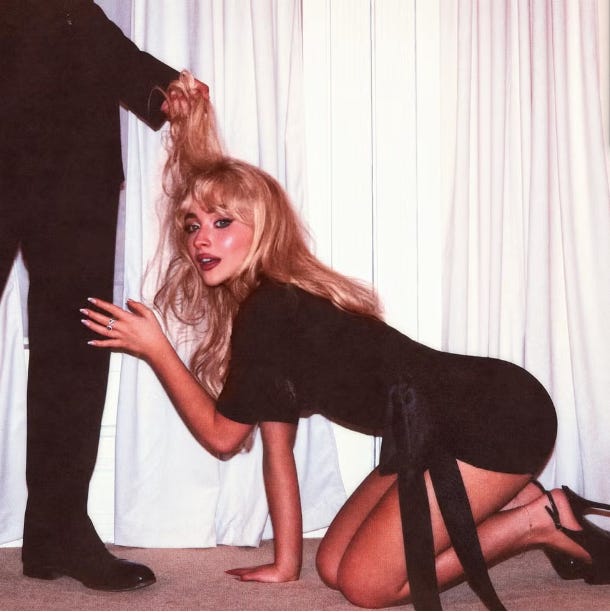Sabrina Carpenter is a performance artist. And I think the latest performance is kind of boring:
Earlier this year, I recorded a podcast with
where we discussed Carpenter as a sort of pop star Marina Abramović. Performance art, in its most basic definition, is about presence, embodiment, and risk. Carpenter checks every box. Her work is about being looked at, relentlessly and deliberately — her image not just consumed but constructed with such intensity that the construction becomes the art. She’s not just selling sex; she’s selling the act of selling it. And that recursive loop is, in itself, a spectacle.Which is why the cover art for Man’s Best Friend feels so strangely flat. On all fours, dressed like a Bratz doll with tenure, Carpenter is positioned like a well-groomed pet while a man’s hand (kind of violently) pulls a fistful of her hair. Her expression is blank, sexy, unbothered. The image is meant to provoke, obviously. It's pornified, campy, BDSM-coded — but with the affect dialed to mute. What should be dangerous feels stylized to the point of safety.
We’re clearly supposed to ask: is this satire? Is it subversion? Is it just hot?
That ambiguity is what makes Sabrina so fascinating — and frustrating, for some. IMO, her kinship with Dolly Parton has less to do with their vocal styling and more to do with the fact that both women overtly perform the labor of the beauty ideal.
In a behind-the-scenes video for “Please Please Please” (the deluxe version with Dolly, not Barry), Sabrina says she can’t wait to look like Dolly someday. It’s a compliment, but it’s also a wink: a knowing nod to plastic surgery as aesthetic inheritance. Just as Dolly famously sleeps in her makeup (rumor has it her husband never saw her without it) “just in case there’s a fire,” Sabrina seems to understand beauty not as a state of being, but a commitment to artifice. A kind of survival strategy in plain sight.
Unlike me, the internet isn’t mad that Sabrina’s performance art isn’t as good on this album cover. As you likely already know (and maybe are tired of hearing about?), the internet is split into one camp that is offended by the cover (see: the very first comment on the IG announcement below) and another that reads it as part of Sabrina’s meta feminist project.
captures one side of that split (sort of - her perspective is nuanced!). In her recent post, she celebrates Carpenter as “our straight little sister who is in on the joke.” Jolie views the album cover as an extension of Carpenter’s Camp sensibility, something queer femmes have long celebrated for its “subversive and playful potential.” I agree entirely! It’s not just that Sabrina is hot and kinky — it’s that she’s hot and kinky in a way that knows it’s a bit. She’s not selling submission; she’s selling the performance of submission, blown out to cartoonish proportions.Jolie makes another important point: the backlash to the cover isn’t new. It’s just the same old script, another round of the feminist porn wars—hand-wringing over whether a sexual image can ever be liberatory, and whether a woman’s agency counts if it’s hot enough to be profitable. These arguments flatten the complexity of what's actually happening in the image: the fact that it might be satire, it might be dangerous, it might be both?
This question is taken up by
in a TikTok response to the cover. Stein points out that satire always exists in response to something, but rightly asks “What is this in reaction to?” She connects Carpenter’s visual identity to a reactionary shift away from millennial internet feminism — the earnest girlboss adjacent feminism of the 2010s. Stein frames Sabrina as possibly trolling that whole aesthetic: the career empowerment seminars, the Dove Real Beauty campaigns, the insistence that sexual empowerment must look like strength, not play.What Stein hints at —and what I agree with— is that Carpenter’s work isn’t trying to free us from the beauty standard. It’s trying to make a joke out of being caught in it. She’s not transcending the trap. She’s bedazzling it.
I’m very struck by that last Instagram comment in response to the album cover (and obviously so were the ~24,000 people who hearted and the 329 people who responded) in which a fan says “as a dv survivor this made me uncomfortable and I’d rather see her empowered.” …Back to my point about Sabrina as a performance artist. Performance art provokes. It’s often more about the conversation after the fact than the performance itself. It is the craft of making the audience participate.
So what happens when a lot of your audience is kids? Or women who love you because of your misandrist lyrics and videos — famously, in the Sabrina Carpenter Cinematic Universe, women never die.

This question made me think of
’s viral Substack, “Your Fave Is Selling a Pedophilic Fantasy”. Hurley points out that Carpenter specifically evokes a schoolgirl aesthetic filtered through pornographic tropes that have long catered to male fantasy. Hurley writes:It’s not subversive to replicate a sexualized schoolgirl fantasy that’s been marketed to men for decades — especially when the audience is too young to know what it’s referencing.
This is the moment when the conversation turns. Because what happens when satire becomes indistinguishable from the thing it mocks? What happens when the hot girl on her knees is so good at the bit that the bit becomes invisible? Carpenter might be in on the joke — but the algorithm isn’t. Neither are the 14-year-olds who think this is just what postfeminist power looks like.
Hurley’s critique is essential because it reminds us that context matters. That the reception of an image doesn’t live solely in the artist’s intent. That some visual codes — especially those built from decades of sexual violence disguised as flirtation — can’t be reclaimed through styling alone. And that femme performance, even when done with irony, still moves through dangerous circuits of consumption.
So where does that leave us?
Carpenter has given us an image in the cover for Man’s Best Friend which, for once, she’s not Lolita-ing it up. In fact, she’s more covered than usual. No visible cleavage, no schoolgirl skirts. Just a dead stare and a man’s hand in her hair, posed like a pedigree show dog.
It leaves us, maybe, with a portrait of a pop star suggesting that adulthood itself is violent. That to grow up —especially as a woman groomed for girlhood appeal— is to be manhandled, mastered, made into a bitch in every sense. It recalls those '90s high-gloss fashion editorials: Cindy Crawford posed with a snarling Doberman, the era’s idea of empowerment dripping in domination. The message was clear then, as it is now: the adult woman isn’t innocent, she’s dangerous. Or, at the very least, she provokes danger.
Carpenter knows the aesthetic she’s working with is toxic. That’s the point. She’s not detoxing it —she’s metabolizing it. For attention, for fun, and yes, for money. And maybe that’s where the exhaustion sets in. When even the critique is part of the performance, it’s hard to tell when the camera stops rolling.
Still, I’m watching.
I’m hoping this is just the beginning — a still from the first act of a long, slow revenge album. One where the Carpenter on her knees in the album cover eventually kills the man behind the hand. Buries him in the backyard. Steals his golden doodle, maybe.
My wish for pop music in 2025: Coralie Fargeat (director of The Substance) shoots the next Sabrina video. I want body horror. I want the long-awaited exorcism of the good girl pop star. And you know what? I actually think Sabrina Carpenter is exactly the woman who would give us that.










A treat to be in conversation with you! I think I need to understand more of her work to see the performance art (all I really know are her catchy radio hits)
don't forget that the priest who let Sabrina Carpenter perform in his Williamsburg church got fired, AND that incident led to the feds/whoever checking in on him and his money stuff which also led to ... the mayoral indictment in NYC. Sabrina Carpenter ... on the side of justice?????